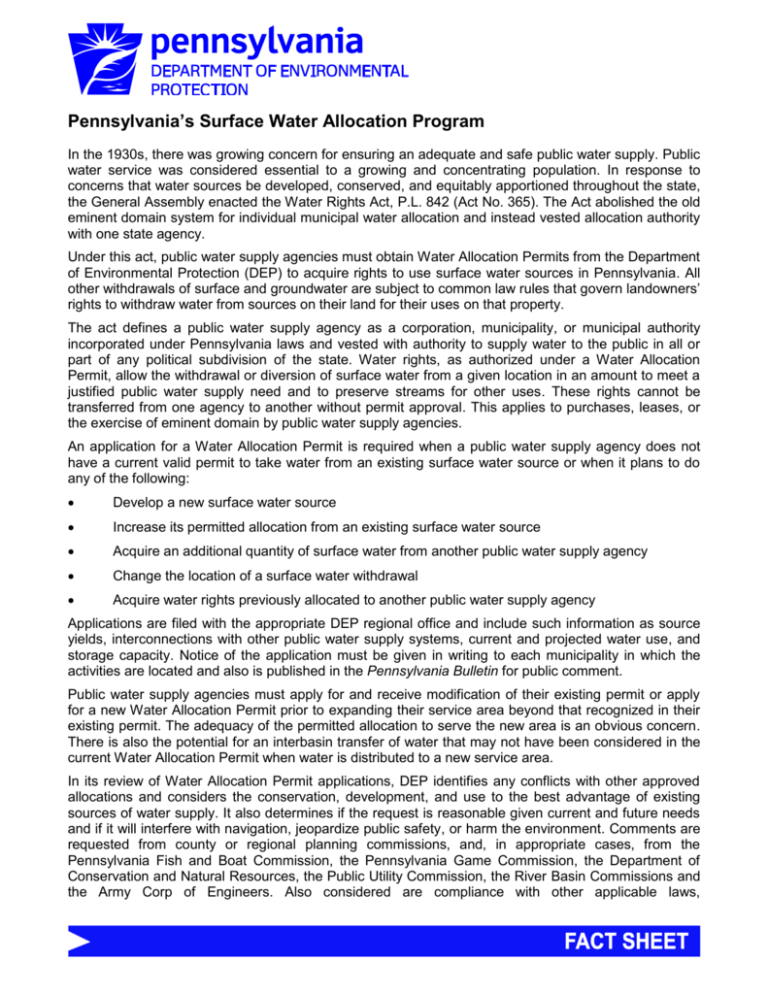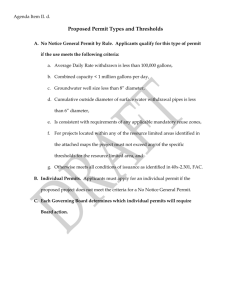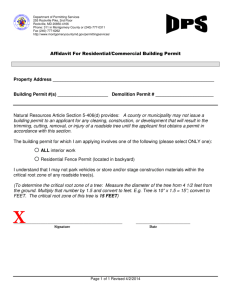Pennsylvania's Surface Water Allocation Program
advertisement

Pennsylvania’s Surface Water Allocation Program In the 1930s, there was growing concern for ensuring an adequate and safe public water supply. Public water service was considered essential to a growing and concentrating population. In response to concerns that water sources be developed, conserved, and equitably apportioned throughout the state, the General Assembly enacted the Water Rights Act, P.L. 842 (Act No. 365). The Act abolished the old eminent domain system for individual municipal water allocation and instead vested allocation authority with one state agency. Under this act, public water supply agencies must obtain Water Allocation Permits from the Department of Environmental Protection (DEP) to acquire rights to use surface water sources in Pennsylvania. All other withdrawals of surface and groundwater are subject to common law rules that govern landowners’ rights to withdraw water from sources on their land for their uses on that property. The act defines a public water supply agency as a corporation, municipality, or municipal authority incorporated under Pennsylvania laws and vested with authority to supply water to the public in all or part of any political subdivision of the state. Water rights, as authorized under a Water Allocation Permit, allow the withdrawal or diversion of surface water from a given location in an amount to meet a justified public water supply need and to preserve streams for other uses. These rights cannot be transferred from one agency to another without permit approval. This applies to purchases, leases, or the exercise of eminent domain by public water supply agencies. An application for a Water Allocation Permit is required when a public water supply agency does not have a current valid permit to take water from an existing surface water source or when it plans to do any of the following: Develop a new surface water source Increase its permitted allocation from an existing surface water source Acquire an additional quantity of surface water from another public water supply agency Change the location of a surface water withdrawal Acquire water rights previously allocated to another public water supply agency Applications are filed with the appropriate DEP regional office and include such information as source yields, interconnections with other public water supply systems, current and projected water use, and storage capacity. Notice of the application must be given in writing to each municipality in which the activities are located and also is published in the Pennsylvania Bulletin for public comment. Public water supply agencies must apply for and receive modification of their existing permit or apply for a new Water Allocation Permit prior to expanding their service area beyond that recognized in their existing permit. The adequacy of the permitted allocation to serve the new area is an obvious concern. There is also the potential for an interbasin transfer of water that may not have been considered in the current Water Allocation Permit when water is distributed to a new service area. In its review of Water Allocation Permit applications, DEP identifies any conflicts with other approved allocations and considers the conservation, development, and use to the best advantage of existing sources of water supply. It also determines if the request is reasonable given current and future needs and if it will interfere with navigation, jeopardize public safety, or harm the environment. Comments are requested from county or regional planning commissions, and, in appropriate cases, from the Pennsylvania Fish and Boat Commission, the Pennsylvania Game Commission, the Department of Conservation and Natural Resources, the Public Utility Commission, the River Basin Commissions and the Army Corp of Engineers. Also considered are compliance with other applicable laws, reasonableness of efforts to minimize environmental harm, and whether the benefits of the proposed project will outweigh any harm caused. DEP considers any comments received and documents its findings. If no conflicts or problems are identified, the Water Allocation Permit is issued with appropriate conditions. Water Allocation Permits may be issued for terms up to 25 years. Permits generally contain requirements to measure and record withdrawal and instream flow amounts, implement water conservation programs, adopt drought contingency plans, and submit annual permit compliance reports. Permits may also contain requirements for: Instream flow protection where the surface water withdrawal may significantly impact instream and downstream uses Reduction of leakage and loss where this is greater than 20 percent Consideration of additional water storage where a system’s storage is less than one day’s supply Development of an additional source where the supply is not sufficient to meet present demand during a 50-year, or less, drought event Water suppliers are required to submit a monthly report of daily water withdrawals and instream flow amounts and complete an annual permit compliance report. The permit compliance report includes information on source and service meter testing, per capita water use, water conservation, and leak detection efforts as well as compliance with any special conditions in the permit. For more information, visit www.dep.state.pa.us, keyword: Water Allocation. Commonwealth of Pennsylvania www.dep.state.pa.us Department of Environmental Protection 3940-FS-DEP4107 Rev. 8/2015





